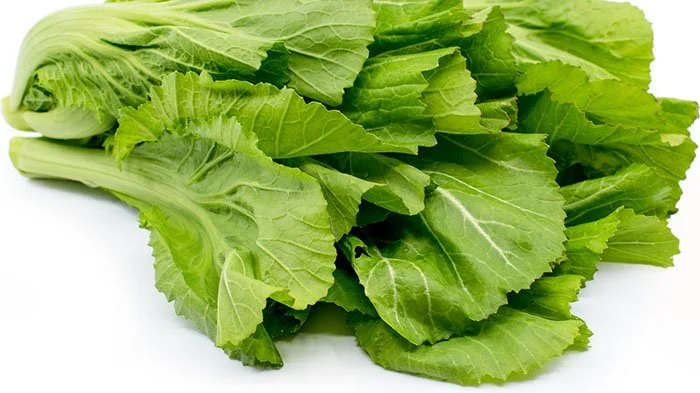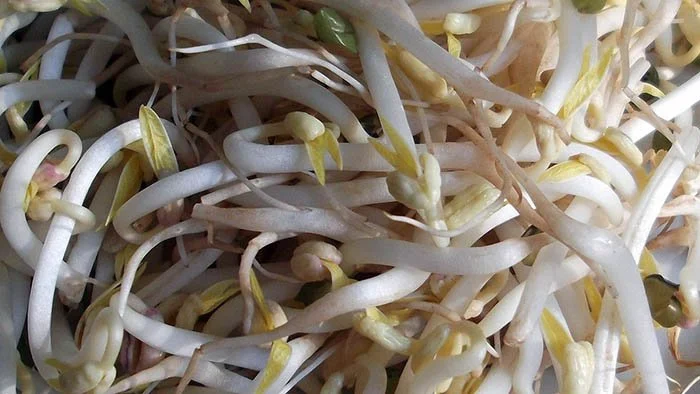What Are Asian Greens & Chinese Greens?
Asian greens and Chinese greens are terms used for any number of leafy green vegetables that find their origins in Eastern Asia. These are typically a staple of Asian cooking and have been incorporated into other diets worldwide.
They include foods like:
Bok choy
Choy sum
Chinese mustard greens (gai choy)
Gai lan (Chinese broccoli)
Napa cabbage
Water spinach (ong choy)
Chrysanthemum leaves
Lotus root
Mung bean sprouts
Snow pea shoots (dau miu)
Guide to Asian Greens and Vegetables
While these vegetables may have roots deep in Eastern Asia, they’ve moved beyond the traditional foods found in their native countries. Recently, we’ve seen an increase in the use of Asian vegetables in places like the U.S., Australia, and beyond.
In addition to adding new and novel flavors to Western diets, Asian greens bring nutritional benefits worthy of notice. They are high in iron, calcium, manganese, potassium, and other minerals. They also contain significant levels of vitamins A, C, and K.
10 Popular Asian Greens and Vegetables
1. Bok choy
Bok choy is a Chinese cabbage and one of the most common Asian greens in western dishes. Rather than the round shape of some cabbages, bok choy has an elongated shape, more similar to romaine lettuce.
This delicious veggie is an excellent source of vitamins A, B6, C, and K, as well as folate and calcium. Its flavor is often compared to a lighter cabbage flavor with hints of celery.
There are several ways to serve bok choy. Familiar recipes are stir-fried, braised, or roasted greens. It can also be added to salads or used to make lettuce boats.
Bok choy is typically available in most supermarkets and is in season during the late summer and early fall months. To keep your bok choy fresh, ensure it remains as dry as possible. Shake any dirt or debris off the leaves, and do not wash them before storage. Instead, wrap the entire head in aluminum foil, then place it in a plastic bag in your refrigerator’s crisper drawer. Once ready to use, wash the leaves to remove contaminants.
2. Choy sum (yu choy)
Choy sum is a sweet-tasting Asian green with a texture similar to that of bok choy. It’s actually a part of the rapeseed family and is often used to produce cooking oil. They’re most delicious when picked early in their growing process, and many growers trim only the tops of the plants, allowing them to regrow again and again.
This low-calorie Asian green is a good source of fiber and antioxidants. It also contains a good deal of folate and B-complex vitamins like thiamin, riboflavin, and niacin.
Choy sum is a common staple in salads, soups, and stir-fries. It pairs well with chicken, mushrooms, tofu, and seafood. It can also be served steamed or blanched, typically with a dressing of garlic sauce or oyster sauce.
This delicate green is typically in season in the mid-to-late spring and then again in the early fall. Look for leaves and stems that are firm and rigid, with no signs of wilting. Store these greens in a humid environment like the crisper drawer of your refrigerator.
3. Gai Choy (Chinese mustard greens)
Chinese mustard greens are actually a category of greens rather than a single variety. They are typically pickled, salted, or preserved in some way and are popular in both Chinese and Indian cooking.
These winter greens are hearty enough to grow even in the snow and offer a bitter flavor similar to arugula or radicchio. When combined with aromatics like dried chilis, garlic, and ginger, they can be quite tasty.
Chinese mustard greens are a beneficial source of many vitamins and minerals and also contain anti-inflammatory phytonutrients. In fact, in Chinese folk wisdom, many believe that the more bitter the vegetable, the better they are for you.
4. Gai lan (Chinese broccoli)
You’ve probably seen Chinese broccoli on menus in some of your favorite restaurants. This thick-stalked leafy green is actually not broccoli at all, but is more closely related to cabbage, collard greens, and kale.
Gai lan is a veggie that you’ll likely see in supermarkets year-round but is best in cooler seasons when the plant thrives. It has a slightly bitter, slightly sweet taste that is not dissimilar to broccoli.
The nutritional benefits of Chinese broccoli include extremely high levels of vitamins A and C, along with fiber and some iron and calcium. While it can be eaten raw, gai lan is usually lightly cooked. To store this delicious green, refrigerate it in a breathable plastic bag in the crisper drawer. If you want to preserve your greens longer, you can blanch them, rinse them with cold water, then freeze them.
5. Napa cabbage
If you’ve ever enjoyed traditional Korean kimchi, you’ve likely had napa cabbage. This cool-season veggie grows in an oval-shaped head and is harvested before the plant flowers. It’s related to the cabbage or mustard greens family and is also closely related to broccoli.
In addition to pickling the cabbage to create one of Korea’s favorite flavors, you may also see it in salads, soups, or as a filling for dumplings. In fact, we've found more than a dozen different ways to serve napa cabbage because it’s an extremely versatile food.
Napa cabbage is prized for its high fiber content, antioxidants, and vitamins and minerals like vitamins B6, B9, C, and K, alongside copper, iron, calcium, and manganese. To store fresh napa cabbage, place the unwashed head in a plastic bag in the crisper drawer of your refrigerator.
6. Ong Choy (Water spinach)
Water spinach is a delicious veggie cultivated throughout Southeast, South, and Eastern Asia. It’s a leafy green that’s actually part of the morning glory family and not related to spinach at all. It comes in both white-stem and green-stem varieties and is actually an invasive species, so great care should be taken when growing the plant.
Water spinach is most often served in a stir fry with flavors like salt, garlic, and ginger. It’s an excellent pairing for fermented tofu but can also be served with shrimp paste or other sauces.
Water spinach is harvested year-round in some areas but is considered “in season” during the summer and early fall. Store it in the crisper drawer wrapped in the plastic bag it was sold in, and try to use it within a day or two of purchase. It will reward you with antioxidants, vitamins C and A, and several of the B-complex vitamins.
7. Chrysanthemum leaves (tong ho)
Chrysanthemum leaves are a favorite in many Asian households. Medium-leaf varieties are often served in soups, while delicate and large-leaf tong ho varieties are favored for salads and even brewed into teas.
Tong ho has exceptional levels of fiber, vitamin A, and calcium with a woodsy taste that is prized for its uniqueness. In general, it’s available year-round, though the flavor is more intense in hotter weather. It should be consumed within days of purchase and is best kept wrapped in plastic in the crisper drawer.
8. Lotus root
While not a type of green, lotus root is an increasingly popular Asian vegetable that is spreading across the globe. These white or off-white discs are an eye-catching addition to many dishes and can be served cold or hot.
The pretty and delicate veggie has a texture similar to potato with a mild and fresh flavor that is incredibly versatile. It features plenty of vitamins A, C, and D, plus minerals such as calcium and iron.
Store your lotus root as it came packaged from the store without separating the bulbs. Before cooking, peel the reddish-brown skin and soak it in water with a splash of vinegar to prevent discoloration. If you plan to serve your lotus root on a salad or other raw dish, you’ll still want to blanch it first to take away some of the bitterness.
9. Mung bean sprouts
Mung bean sprouts are microgreens that are popular with chefs in China, Korea, and Thailand, while increasingly becoming a favorite in western diets as well. They’re exceptionally easy to grow and can be served in stir-fries, on salads, or in dishes such as spring rolls or curries.
Bean sprouts are often seen as a health food, as they are an excellent source of fiber and contain more plant protein than most greens. They’re also rich in both vitamin C and antioxidants.
When you bring bean sprouts home from the grocery store, rinse them in cold water, drain them, and pat dry. Then place them in a plastic bag lined with paper towels and store them in the coldest part of your refrigerator. If you need to keep them for more than a few days, submerge them in ice water and be sure to change the water out daily.
10. Dau Miu (Snow pea shoots)
Snow pea shoots are frequently served stir-fried with garlic and other aromatics. These small, tender leaves are lightly sweet and a favorite of many across Asia.
Snow pea shoots are known to be high in both protein and fiber and rich in vitamins A, C, and K. They’ll keep best by placing unwashed pea shoots in a plastic bag and storing it in the refrigerator.
Nutritional Benefits of Asian Vegetables
As you can see above, there are a wide variety of Asian greens, and each has its own nutritional profile. Generally, most are high in fiber and offer benefits like antioxidants, vitamins A, C, and K, and minerals such as iron, calcium, and more.
The nutrition found in these delicious greens is an excellent way to promote overall health, but they can specifically help decrease the risk for some chronic diseases.
Culinary Uses of Asian Greens
Asian greens have a variety of uses in the kitchen. Here are a few to try:
Salads – while the ubiquitous “Asian salad” of past decades really had very little to do with actual Asian cuisine, many of the greens listed above are delicious additions to your favorite green salads or for serving on sandwiches.
Stir fry – A favorite cooking method throughout much of Asia, stir-frying these vegetables can help bring out the best of their flavors without taking too much time or effort. Throw in aromatics like garlic and ginger and mix with your favorite veggies and proteins for a quick and easy meal that is infinitely customizable.
Soups – If you have a little more time (or patience), try cooking your Asian greens into ramen or other soups. It’s best to add such delicate ingredients toward the end of the cooking process to keep them looking and tasting their best.
Steaming – A simple dish of steamed greens with your favorite Asian sauces or spices can be a delightful addition to nearly any meal.
Growing and Harvesting Asian Greens and Chinese Greens
When you want to add Asian greens to your grocery store’s stock, it’s hard to go wrong with hydroponically-grown greens that are fresh and tasty year-round.
A partnership with Eden Green Technology gives you access to the freshest greens, regardless of season or climate. Snap peas, pak choi, and Chinese celery are just a few of the produce options we can provide to help your brand incorporate the flavors of the Far East.
The benefits of hydroponics from Eden Green Technology include the best standards in food safety, far fewer food miles, and a sustainable set-up that’s designed to make hydroponic produce deliciously accessible to your customers. Contact our team to learn how we can bring Asian greens to your store or restaurant today.











